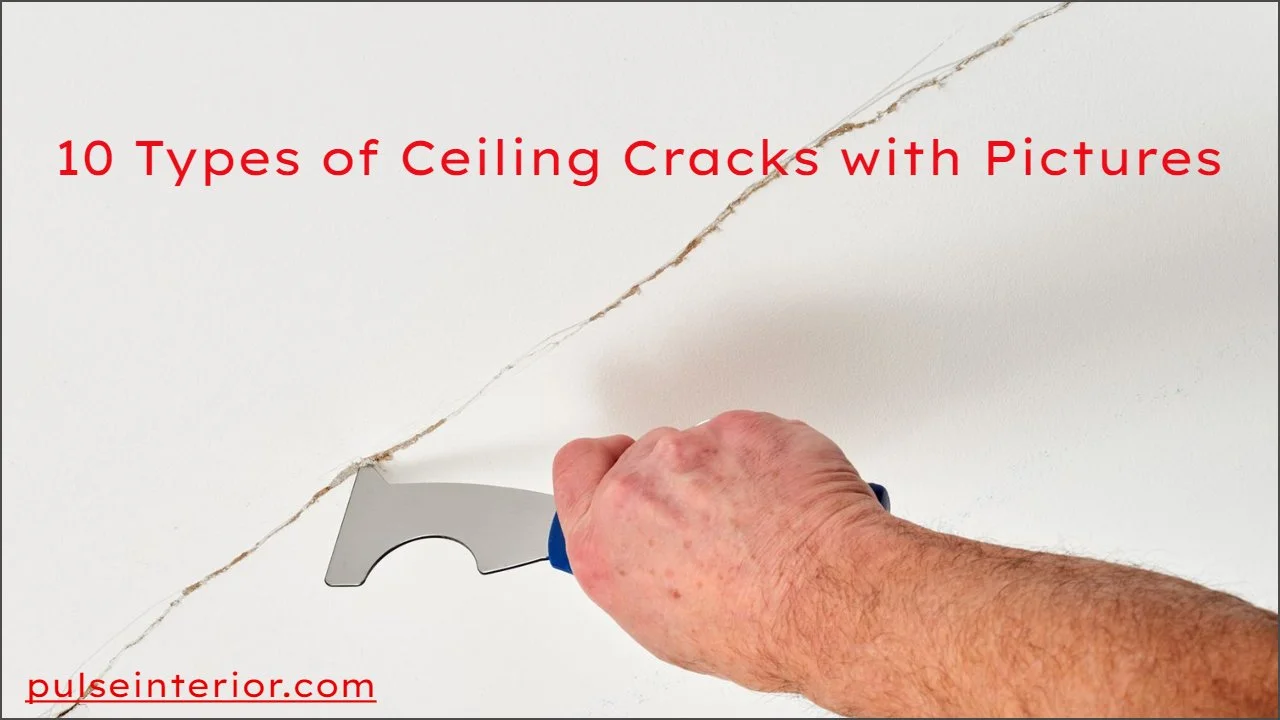Ceiling cracks are more than just cosmetic flaws; they can be early warning signs of serious structural issues within a home. According to the American Home Inspectors Association, about 30% of ceiling cracks are purely cosmetic, while 20% indicate structural concerns that may require professional intervention. Additionally, water damage accounts for 35% of ceiling crack cases, especially in humid regions or older homes. In this guide, we’ll cover 10 types of ceiling cracks with pictures, examining their causes, risks, and how to address them. By understanding the distinctions between each crack type, homeowners can make informed decisions on whether a crack can be ignored, repaired, or needs professional evaluation.
What are Ceiling Cracks?
Ceiling cracks are visible lines or fissures that appear on the surface of a ceiling, often caused by factors like the natural settling of a building, temperature changes, structural shifts, or water damage. While some cracks are purely cosmetic, such as hairline cracks resulting from minor shifts or paint shrinkage, others can indicate more serious underlying issues. Wide cracks, expanding, or appearing in specific patterns may signal structural concerns, foundation movement, or excessive load on the ceiling. Recognizing the various Types of Ceiling Cracks with Pictures can help homeowners assess whether they are harmless or require immediate repair and professional inspection.
10 Types of Ceiling Cracks with Pictures
1. Hairline Ceiling Cracks

Hairline ceiling cracks are fine, narrow fissures—usually less than 1mm wide—that often appear as faint lines across the ceiling. These cracks may form in random areas or align with the seams of drywall panels. Typically, they are shallow and cosmetic, posing no immediate structural concerns. Such cracks are especially common in newer homes, as building materials naturally settle, expand, and contract over time.
Common Causes of Hairline Ceiling Cracks
- Natural Settling of Homes:
Newly constructed homes are prone to hairline cracks as the structure adjusts to its environment. Settlement of the foundation and minor shifts in framing can lead to these minor imperfections. - Material Expansion and Contraction:
Temperature and humidity changes cause building materials like wood and drywall to expand and contract, resulting in these small cracks over time.
Assessing the Risk Level
Hairline ceiling cracks are generally low risk and primarily a cosmetic issue. They don’t usually indicate structural problems, but it’s wise to monitor them. If cracks begin to widen, deepen, or show discoloration, it could signal underlying issues such as water damage or structural stress, which would require professional attention.
Tips for Homeowners
- Monitor Regularly: Keep an eye on the cracks to ensure they don’t grow or change.
- Perform Cosmetic Repairs: Use filler or paint to restore the ceiling’s appearance if desired.
- Inspect for Warning Signs: Cracks that increase in size or show additional symptoms (like staining) may require expert evaluation.
By understanding the nature of hairline ceiling cracks and their causes, you can maintain peace of mind and focus on appropriate maintenance steps to keep your home in excellent condition.
2. Spiderweb Ceiling Cracks
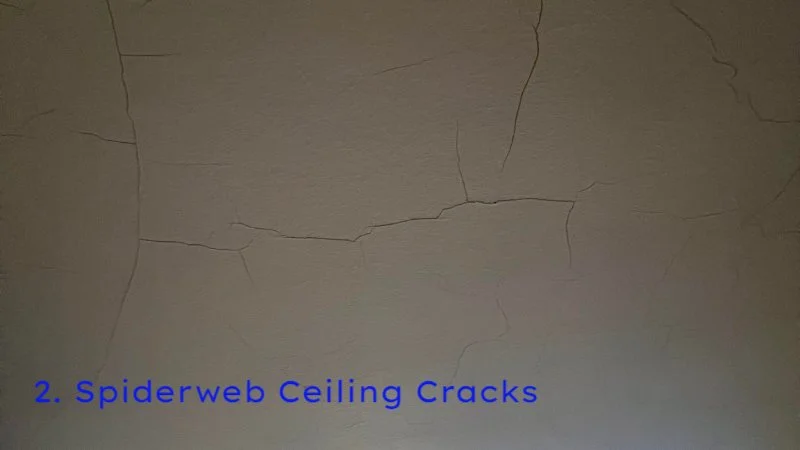
Spiderweb cracks are fine, branching fissures that radiate out from a central point, often resembling a web. These cracks usually appear in a circular pattern and can be a sign of underlying issues at the center. They commonly occur in areas with high humidity or frequent temperature fluctuations, such as bathrooms or kitchens, and may also indicate improper drywall installation. While spiderweb cracks are typically minor, they can sometimes point to potential structural shifts that require attention.
Common Causes of Spiderweb Cracks
Minor Foundation Shifts: Small movements in the foundation can lead to stress on the walls, causing these cracks to appear. These shifts are often harmless but can indicate a need for further inspection if they worsen.
Water Damage: Excess moisture can weaken drywall or paint, leading to the formation of cracks. High humidity or plumbing issues are common culprits.
Temperature and Humidity Changes: Rapid changes in temperature and humidity cause building materials to expand and contract, which can result in these cracks over time.
Assessing the Risk Level
Spiderweb cracks are usually low-risk, though they can suggest structural stress, especially if they appear in multiple areas. While often cosmetic, homeowners should monitor these cracks for any expansion. If they begin to widen or deepen, it may signal more serious issues, such as foundational shifts or water damage, that require professional assessment.
Tips for Homeowners Regular Monitoring: Keep an eye on the cracks to check for any growth or changes. Perform Cosmetic Repairs: If desired, use fillers or paint to maintain the appearance of the walls. Seek Professional Help: If cracks expand or show signs of underlying issues, consult an expert for a thorough evaluation.
3. Straight Ceiling Cracks

Straight cracks are narrow fissures that typically appear along the seams where drywall panels meet, often extending across the entire length of a room. These cracks result from drywall seam separation, which is common in areas of the home that experience frequent seasonal temperature fluctuations. Over time, the drywall tape can loosen, causing the seams to separate and create thin, straight cracks. While these cracks are typically shallow and cosmetic, they can become more noticeable if not addressed promptly.
Common Causes of Straight Cracks
Drywall Seam Separation: The most common cause of straight cracks is the natural separation of drywall seams, often due to the shifting and settling of the building over time.
Expansion of Building Materials: Temperature and humidity changes can cause building materials, such as drywall, to expand and contract. This natural movement can lead to the loosening of drywall tape and the formation of straight cracks.
Assessing the Risk Level
Straight cracks are generally considered low to medium risk. They are often a cosmetic issue and can be easily repaired by re-taping and repainting the affected seams. However, if the cracks worsen or continue to expand over time, further investigation may be necessary to rule out underlying issues, such as foundation movement or structural stress.
Tips for Homeowners
- Monitor for Changes: Keep an eye on the cracks to see if they widen or worsen over time.
- Repair as Needed: If the cracks remain stable, they can typically be fixed by re-taping the seams and repainting.
- Consult a Professional: If the cracks continue to expand or if you notice other signs of structural issues, seek professional advice to ensure there are no underlying problems.
By understanding the causes and potential risks of straight cracks, homeowners can take proactive steps to maintain the appearance and integrity of their walls.
4. Diagonal Ceiling Cracks
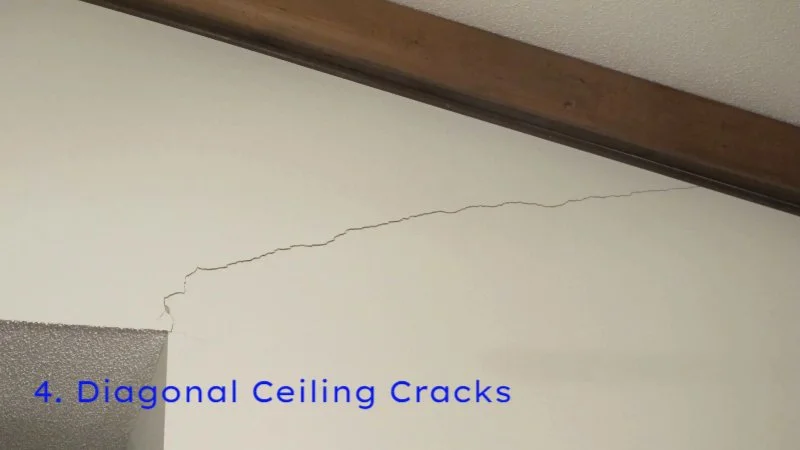
5. Curved or Arched Ceiling Cracks
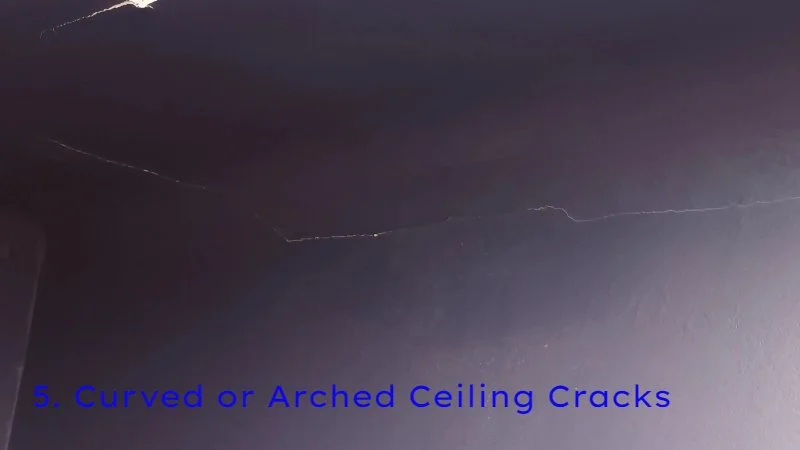
Curved or arched cracks form a gentle bend rather than following a straight line. These cracks often appear near the edges of ceilings or around support beams and are typically found in areas where the foundation is settling gradually. The shifting of materials under pressure can lead to stress along the ceiling edges, resulting in these types of cracks. While curved cracks grow slowly, they should still be monitored over time for any changes.
Causes: Curved cracks are generally caused by natural foundation settling and stress placed on joints. As the structure adjusts and materials shift, stress points can lead to cracks along these vulnerable areas, especially at joints or where weight is concentrated.
Risk Level: Medium. Although these cracks are usually not an immediate concern, they can develop into more serious issues if they expand or deepen over time. Regular monitoring is recommended to assess whether further structural evaluation is needed.
6. Stair Step Cracks
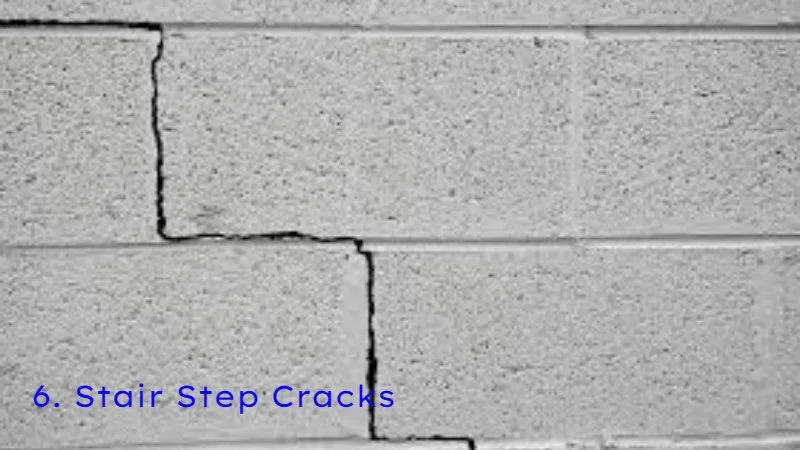
Stair-step cracks form a distinct staircase-like pattern, traveling along walls and ceilings. They often appear in older homes with foundational settling issues, frequently originating near load-bearing structures. These cracks may start at the base of a wall and extend upward into the ceiling, potentially widening over time if left unaddressed.
Causes: Stair-step cracks are typically caused by foundational settling or shifting, often due to uneven structural pressure. Poor drainage, soil erosion, or expansive clay soils beneath the foundation can exacerbate the problem.
Risk Level: High. These cracks require immediate attention from a structural engineer, as they may indicate significant foundation damage or instability. Addressing them promptly can prevent further structural deterioration.
Prevention and Repair: Installing proper drainage systems, ensuring soil stability, and reinforcing the foundation can help mitigate stair-step cracks. Professional repairs, such as underpinning or crack sealing, may also be necessary depending on the severity of the damage.
7. Bowed Ceiling Cracks
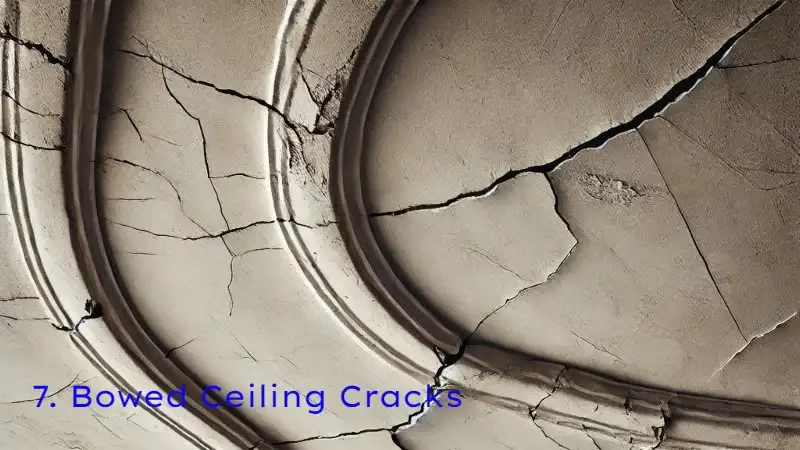
Bowed ceiling cracks occur in areas where the ceiling is sagging or bowing downward, often forming perpendicular to the sagging section. These cracks are commonly found in spaces subjected to heavy loads, such as an overloaded attic or areas impacted by water leaks. They can signal significant stress or weakened structural support, which should not be ignored.
Causes: Bowed ceiling cracks typically result from excessive weight above the ceiling, such as heavy storage in an attic or water damage from persistent leaks. Compromised ceiling joists, insufficient support, or prolonged exposure to moisture can exacerbate the issue.
Risk Level: High. These cracks indicate potentially dangerous structural problems and require immediate attention. Left unaddressed, they may lead to ceiling collapse or further structural damage.
Prevention and Repair: Regularly inspect ceilings for signs of sagging or water damage. Avoid overloading attics, ensure proper insulation to prevent moisture buildup, and promptly repair any leaks. Structural reinforcements, such as additional joists or professional repairs, may be necessary to restore stability and prevent future damage.
8. Cracks Around Fixtures
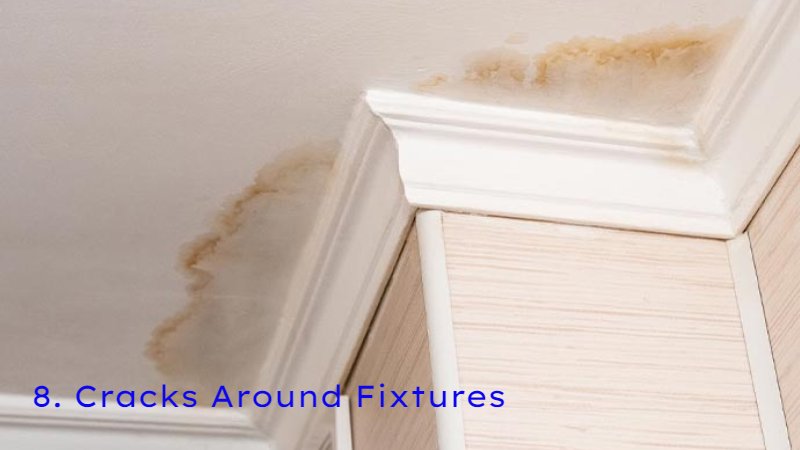
These cracks appear as small, narrow lines surrounding ceiling fixtures such as lights, fans, or vents. They commonly develop due to shifting fixtures, improper installation, or natural settling of the building materials around the fixture. Typically, these cracks remain confined to the immediate area but may expand over time if the fixture continues to shift.
Causes: Cracks around ceiling fixtures are often caused by minor movements of the fixture, poor installation techniques, or the natural settling of the ceiling materials. Changes in humidity or temperature can also contribute to their formation.
Risk Level: Medium. These cracks are not usually structurally dangerous but should be monitored. If the cracks grow larger, appear in multiple areas, or show signs of other damage (such as sagging), further inspection may be necessary.
Prevention and Repair: Ensure fixtures are securely installed and avoid overloading them. Periodic tightening of screws or bolts may prevent movement. Minor cosmetic repairs with joint compound or caulking can restore the appearance of existing cracks. However, consulting a professional may be prudent if the cracks persist or worsen.
9. Peeling Ceiling Cracks
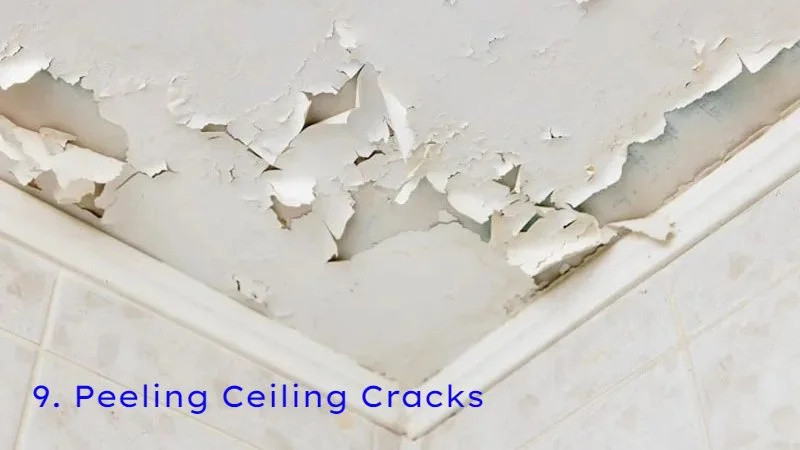
Peeling ceiling cracks are often accompanied by flaking paint or drywall, most commonly seen in high-humidity areas such as bathrooms and kitchens. These cracks form due to prolonged moisture buildup, which weakens the ceiling surface and leads to cracking and peeling. If left unaddressed, peeling ceiling cracks can become a breeding ground for mold, posing additional health risks.
Causes: Moisture accumulation from poor ventilation, water leaks, or high humidity is the primary cause of peeling ceiling cracks. Over time, the moisture deteriorates the paint and underlying drywall, leading to visible damage and structural weakening.
Risk Level: Medium. While these cracks typically do not indicate major structural issues, they require prompt attention to prevent further damage. If mold growth is present, professional remediation may also be necessary.
Prevention and Repair: Proper ventilation, especially in bathrooms and kitchens, is crucial to reducing humidity levels. Fix any water leaks immediately and use water-resistant paint to protect the ceiling surface. Repairing peeling cracks involves scraping away damaged materials, treating the area for mold if necessary, and applying new paint or drywall.
10. Dangerous Ceiling Cracks
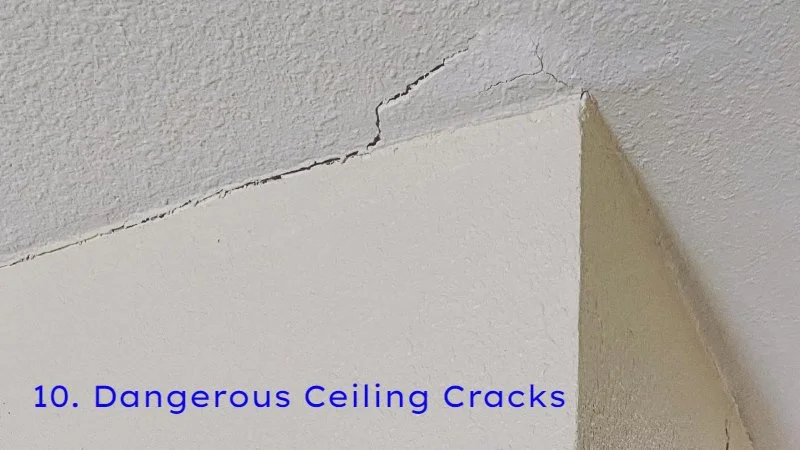
Dangerous ceiling cracks are wide, often rapidly expanding, and can stretch across significant portions of the ceiling. They are typically accompanied by visible sagging, warping, or other structural deformations. These cracks often appear near load-bearing walls, beams, or other critical structural elements, signaling severe underlying issues.
Causes: Dangerous cracks are usually caused by serious foundational shifts, compromised load-bearing structures, or roof failures. Events such as soil movement, water damage, or the excessive weight of building materials can exacerbate these issues.
Risk Level: Very High. These cracks indicate critical structural distress and pose an immediate risk to home safety. Left unaddressed, they could lead to partial or complete ceiling collapse, endangering occupants and causing extensive property damage.
Action Required: Seek immediate evaluation by a structural engineer or qualified professional to determine the cause and extent of the damage. Repairs may involve reinforcing or replacing structural components, addressing foundational issues, or mitigating the root causes of the problem, such as leaks or overloading.
Identifying Dangerous Ceiling Cracks
Understanding the types of ceiling cracks with pictures allows homeowners to assess the severity of each crack and respond appropriately. Dangerous ceiling cracks are typically larger, expanding rapidly, and often occur near structural supports, like beams or load-bearing walls, where the building’s integrity relies heavily on stability. These cracks can signal critical structural shifts, excessive weight above the ceiling, or underlying foundational issues. If left unchecked, they can lead to further ceiling deformations, sagging, or even potential collapse in severe cases. Consulting a structural engineer for these types of cracks is essential, as it not only ensures the safety of those living in the home but also prevents further costly damage by addressing structural concerns at the earliest signs.
Statistical Insights on Ceiling Cracks
Ceiling cracks are a common feature in many homes, but not all are cause for concern. According to a study by the American Home Inspectors Association, 30% of ceiling cracks are purely cosmetic, typically arising from minor settling, temperature fluctuations, or material expansion and contraction. However, 20% of ceiling cracks indicate structural concerns that may require professional inspection and repair, particularly if they grow over time or appear near load-bearing areas. Water damage also plays a major role in ceiling cracks, with 35% of cracks resulting from moisture issues, especially in older homes or in regions with high humidity. These cracks often start as peeling or blistering but can deepen into more severe issues, particularly in bathrooms, kitchens, or areas exposed to leaks. Regular monitoring and maintenance can prevent these cracks from becoming significant issues, allowing homeowners to tackle dangerous ceiling cracks early and minimize repair costs associated with more advanced structural damage.
Conclusion
Identifying ceiling cracks correctly is essential for maintaining a safe and sound home structure. Knowing the types of ceiling cracks with pictures allows homeowners to determine if they are dealing with hairline dangerous ceiling cracks or minor cosmetic issues. Regular inspections, proactive repairs, and professional consultations can prevent small cracks from developing into larger problems. Homeowners should remember to monitor any crack expansion, especially in high-risk cracks like diagonal or stair-step formations, as these are often indicators of structural concerns. By understanding the differences among crack types, you can take appropriate actions and ensure peace of mind for your household.
We hope this article helps you identify ceiling cracks, visit our website daily for more valuable insights and informative articles!
